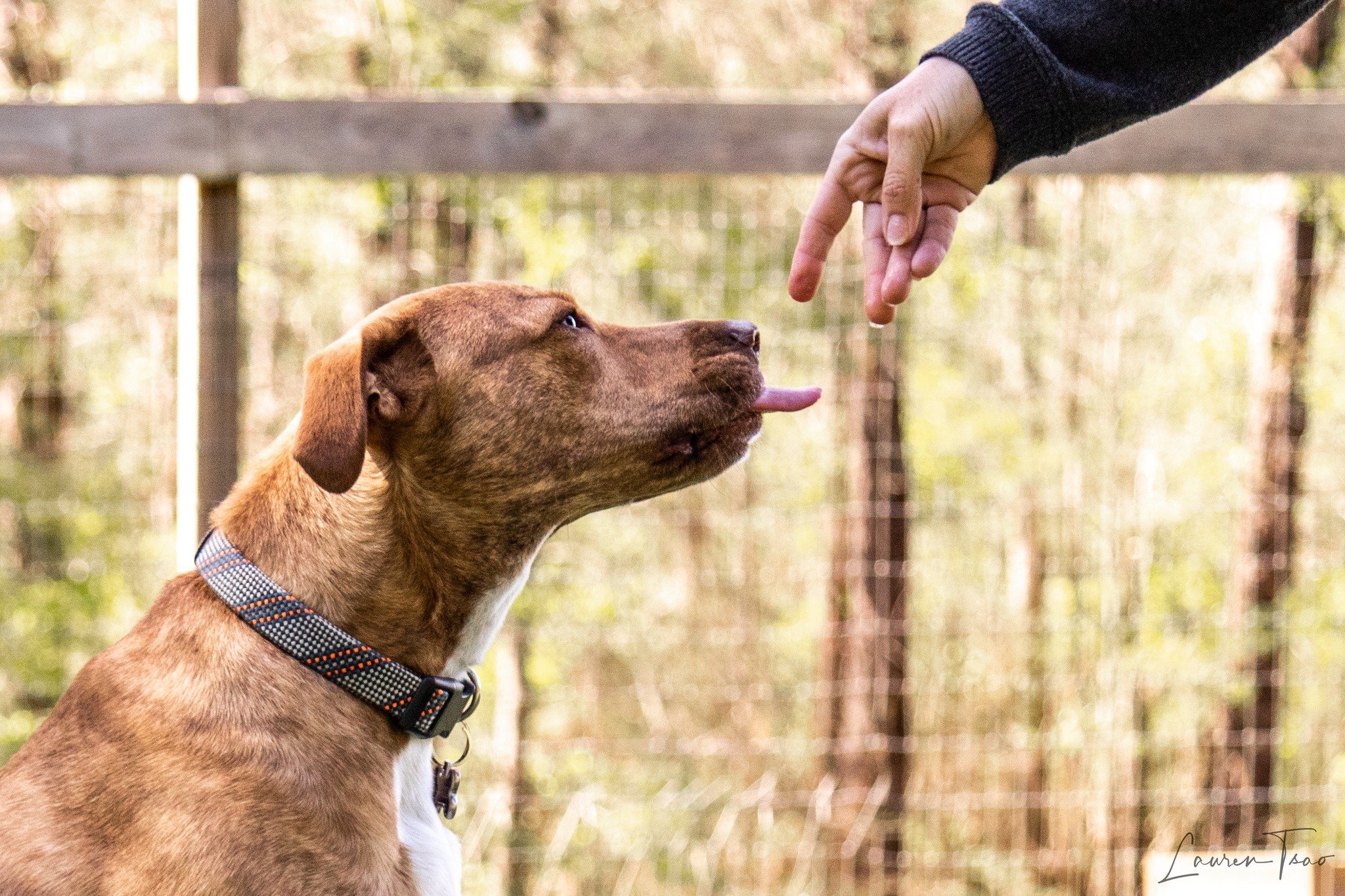
Dog Training & Behavior Tips

Kind to Dogs, Cold to People? The Myth of Positive Reinforcement and Human Empathy
What if using positive reinforcement with dogs doesn’t automatically make us kind to people? Being skilled in behavior science isn’t the same as being compassionate. Empathy with clients matters just as much as mechanics with dogs and truly humane training must include both. Whether you’re a trainer or a dog guardian, this is a must-read reminder that kindness isn’t a technique, it’s a choice.

“I Don’t Have Time”: When Life Feels Too Full for Dog Training
“I don’t have time” is one of the most heartbreaking things a behavior consultant can hear. Making time before things fall apart is one of the kindest things you can do for your dog and yourself. Behavior struggles are more than just inconvenience. They’re quality of life concerns. And small, doable changes really can make a big difference.

Not Just a Trick: Turning Chin Rests into a Vet-Ready Superpower
Think your dog’s chin rest is solid until the vet walks in?
Discover how the Three D’s of dog training: duration, distance, and distraction, can transform a cute behavior into a powerful tool for vet visits, grooming, and daily care. With real-life examples and step-by-step guidance, this post will help you build a chin rest your dog can confidently rely on in the real world.

No Drama: How to Give Your Dog Ear Drops Without a Fight
Giving ear drops doesn’t have to be a daily struggle. We’ll explore why dogs often resist ear care and offer compassionate, practical strategies to make the process easier. From warming the solution and using syringes to applying drops via cotton balls, small changes can dramatically improve your dog’s comfort.

"My Reactive Dog Is Ruining My Life”: An Open Letter
When life with a reactive dog feels overwhelming, it’s easy to believe you’re doing something wrong or that your dog is too far gone to help. This open letter speaks directly to the emotional weight of that experience: the grief, the guilt, the exhaustion, and the deep love that keeps you trying anyway.

Why Your Dog is Still Pulling on Leash
Many dogs struggle with loose leash walking, even after consistent training, the right tools, and professional help. We’ll look at why some dogs continue to pull despite doing everything “right,” and what might really be going on when progress stalls. We’ll review subtle signs that something deeper could be affecting your dog’s ability to walk comfortably, and offers a different way to move forward when training alone isn’t enough.

You Hired a Professional Dog Trainer. Now Let Them Do Their Job!
When you hire a dog trainer or behavior consultant, you’re not just paying for their time, you’re investing in their expertise, methods, and carefully developed process. Yet, many students unknowingly undermine this process by asking their trainer to work outside their area of expertise, change their methods, or skip important steps.
This blog post explores why it’s essential to trust your trainer’s approach, whether it’s using positive reinforcement instead of training collars or following a structured behavior assessment.

Not All Dog Trainers Are Created Equal: What You Need to Know Before Hiring One
This blog post highlights the importance of carefully selecting a dog trainer or behavior consultant due to the unregulated nature of the industry. Anyone can claim to be a dog trainer without any formal education, making it essential for dog owners to evaluate credentials, experience, and methodologies when seeking professional help.

Why is My Dog Aggressive Towards Other Dogs?
Aggression towards other dogs is often a complex behavior influenced by a variety of factors, including fear, frustration, physical discomfort, and environmental triggers. This blog post delves into the common causes of aggression and how to recognize early warning signs.

Classical Conditioning and Your Dog: Understanding How It Shapes Behavior
This blog post explores the concept of classical conditioning and how it influences dog behavior. Classical conditioning, first studied by Ivan Pavlov, explains how dogs (and all animals) can learn to associate neutral stimuli, like sounds or objects, with meaningful outcomes, such as rewards or discomfort…

It Takes a Team: Why Your Dog’s Training Needs Everyone on Board
We explore the challenges of managing dog training responsibilities when one person in the household carries the majority of the "mental load"; the invisible burden of managing tasks like feeding, walking, and training, as well as tracking progress and implementing solutions. We discuss the importance of involving all family members in training, highlighting the risks of inconsistent messaging, increased stress for the dog, and burnout for the primary caregiver.

A Shift in Perspective – It’s Not About “Fixing” Your Dog
This blog post encourages dog owners to shift their mindset from “fixing” their dog’s behavior to focusing on gradual progress through achievable goals. Addressing behavior issues, especially complex ones like aggression or reactivity, requires patience and realistic expectations. Attempting to resolve long-term behaviors quickly can lead to frustration and setbacks, as deep-rooted habits can take months or even years to change…

Navigating Dog Ownership During Autistic Burnout
This blog post offers guidance for autistic dog owners on navigating the challenges of dog care during autistic burnout. Autistic burnout is a state of chronic exhaustion and decreased function due to prolonged stress, often resulting from masking autistic traits, sensory overload, and social expectations. Burnout affects various aspects of dog ownership, including physical energy, tolerance for interruptions, and sensory sensitivity, making routine tasks like feeding, walking, and training difficult to manage…

Is Your Dog’s Car Anxiety a Sign of Pain?
We explore how a dog’s discomfort during car rides may not just be anxiety but a sign of physical pain or discomfort. Dogs experiencing stress during car travel often undergo subtle strain from the vehicle’s movement, needing to make constant balancing adjustments that can exacerbate any underlying pain, particularly in dogs with joint or muscular issues…

When Dog Training Isn’t Enough - a Dynamic Dog Case Study
The case study of A, a 2.5-year-old Feist mix, illustrates how persistent behavior issues often have deeper, underlying causes. Despite extensive training, A continued to struggle with aggression, pulling on walks, and inconsistent eating. A key observation of A's unusual hind-leg skipping led to further investigation. This was when a Dynamic Dog Assessment, an approach that considers the whole dog's physical health, behavior, and environment, revealed subtle discomfort signals that changed A’s life.

How To Write An Organized and Effective Dog Training Plan
Just like any other professional, dog trainers need to have a solid plan in place in order to be successful. This means having a clear understanding of your goals, what you and your student need to do to achieve them, and how you will measure progress along the way. While every trainer's approach will be slightly different, there are some essential elements that should be included in every dog training plan. In this blog post, I'll share some tips on how to write an organized and successful training plan that your students can stick to. By following these guidelines, you can set yourself up for success and ensure that you're providing the best possible experience for your students and their dogs.

What is a High-Value Reinforcer in Dog Training and Why is it Important to Use One?
When it comes to training our furry friends, using high-value reinforcers can make all the difference. These reinforcers, which can come in the form of treats, toys, verbal praise, or even physical affection, provide a clear signal to the dog that they have accomplished the desired behavior. (Check out our big list of reinforcers if you need help thinking of possible reinforcers to try out!) On the other hand, low-value reinforcers, or things you may believe are reinforcing, but aren't, can actually confuse and slow down training progress. So what makes a reinforcer high-value? It varies from dog to dog - for some pooches, it might be a crispy bacon treat, for others, it could be a game of fetch with their favorite toy. The key is to observe your dog's body language and reactions during training sessions and determine which reinforcer gets them the most engaged and increases and strengthens the targeted behavior. Using high-value reinforcers appropriately can not only help keep training sessions fun and engaging for both you and your pup but also increase efficiency and speed in learning behaviors and cues.

Operant or Classical Conditioning In Dog Training: Is It Possible To Use Just One?
If you're new to the world of dog training, you may be wondering what operant conditioning and classical conditioning are, how they differ from one another, and if you can use them separately from one another. Both operant conditioning and classical conditioning are important elements of dog training, and it's important to understand the difference between the two in order to be the best trainer possible. Here's a brief overview of each type of conditioning, as well as a history of their respective pioneers, Ivan Pavlov and B.F. Skinner.

Scared For Life: Single-Event Learning In Dogs
Dogs are smarter than we give them credit for. They can experience something so impactful that it only takes a single time for them to understand that the experience is something to be avoided or scared of. This is called single-event learning (sometimes called a one-time learning event), and it's more common in dogs than you might think. If you have ever trained your dog, you know that usually, it would take many repetitions for your dog to understand the consequences of certain events or actions. However, single-event learning can be so frightening (or in some cases, pleasant) that your dog develops an avoidance, fear, or phobia with a single exposure. Keep reading to learn more about how single-event learning works and what you can do to help your scared dog.

How to Prepare Your Aggressive Dog for Thanksgiving
Thanksgiving is a time to gather with family and friends, enjoy a delicious meal, and give thanks for all that we have. For many of us, our dogs are part of the family. However, the increased activity level and the number of people in the home during Thanksgiving can be overwhelming for even the calmest of dogs. If your dog is aggressive or reactive, it is important to take some extra precautions to ensure that everyone has a safe and enjoyable holiday. With some careful planning and management, you can make Thanksgiving a success for both you and your furry friend.
